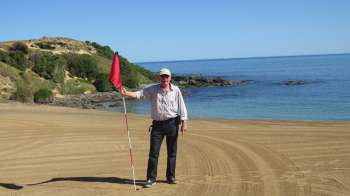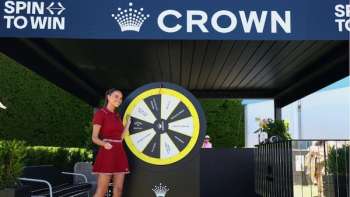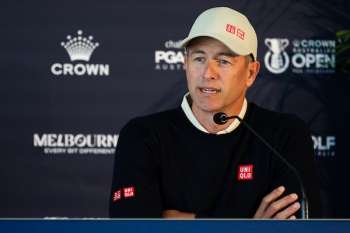Best in Show – Profile of Richard Forsyth, Superintendent at Royal Melbourne Golf Club
Next month the Talisker Australian Masters and the World Cup of Golf will both be held on the Composite Course at Royal Melbourne. It will be the first time in this country since 1988 that major professional events have been held consecutively on the same course. Back then it was the World Cup and the Bicentennial Classic, also hosted by Royal Melbourne.
In advance of the upcoming events, Australian Golf Digest sat down with Royal Melbourne’s course superintendent Richard Forsyth to discuss preparations for the summer of golf, and the responsibility of managing Australia’s most precious piece of golfing real estate.
Profile - Richard Forsyth
Course Superintendent, The Royal Melbourne Golf Club (since 2009)
Previous Employment –
1980 - Apprentice Greenkeeper at Riversdale Golf Club.
1985 - Assistant Superintendent at Yarrawonga and Border Golf Club (during construction of the Murray Course).
1988 - Superintendent at Murray Downs (during construction of the course).
1994 - Superintendent at The Metropolitan Golf Club.
2009 – Superintendent at The Royal Melbourne Golf Club
Darius Oliver – Do you have a favourite hole at Royal Melbourne?
Richard Forsyth – I like the short holes 10 West, 1 East, 3 West, 5 East as they appear simple but can be very challenging, great viewing in tournaments.
DO – What is the hardest two-putt?
RF – 6 West is obvious but there are many if you are not in the right section of the green.
DO – Do you get to play the courses often?
RF – As I was once told, I was not appointed at RM for my golfing ability so although I do have the opportunity to play I much prefer to watch people with much greater ability than me play on the turf that I help to prepare and manage.
DO – What is the best part of your job?
RF – Royal Melbourne is my office, even on the worst day it is a special place. When I first started Greenkeeping instant satisfaction came from doing the tasks to produce premium fine turf. Now it is about making management decisions that create the environment for a team of people to produce quality playing surfaces reflecting the traditions of Royal Melbourne. My job has a great mix of practical, science, management, people and communication skills, all in an outdoor environment. Needless to say, I have never struggled to get out of bed to come to work.
DO – What is the biggest challenge?
RF – There are many but I think the biggest is maintaining pure greens turf, free of Poa annua. When you are set this task it can engulf your life and put all of the Greenkeeping team under pressure. For many golfers grass is grass but to maintain Poa free bentgrass turf remains the biggest challenge and yet the most satisfying if you can achieve the desired result.
DO – What type of player does Royal Melbourne suit and do you think an Adam Scott-led Australia can win the World Cup?
RF – Prior to the Presidents Cup we said the Australian players and the Internationals led by Greg Norman would have an advantage at Royal Melbourne but it did not pan out that way. The intention to have very firm greens means players cannot blaze away and will have to think shots through to be in the best position to hole putts. There are some nasty spots around the greens and bunkers if you miss or roll through, then there is the putting on some wonderfully contoured greens. There is a massive difference playing a firm Royal Melbourne in comparison to watching some of the US Tour events when players have to think about controlling backspin with their approach shots. I was at Muirfield for The Open in July and it was in perfect condition for the best players with so much firmness and bounce, but showed the player that thought it through best came out on top. So in summary, Adam Scott will have some advantage, especially playing in the Masters the week before, but Royal Melbourne, weather permitting, will need a different game than the average tournament course.
DO – How different or difficult is it prepping for consecutive events instead of for just one week?
RF – Back to back tournaments is new to me although Royal Melbourne has done it previously with the Bicentennial Classic and World Cup in December 1988. I think it will be important not to over prepare the greens leading into the Masters in terms of cutting frequency, drying out and rolling. Having said that, the turf at Royal Melbourne does not need much extra preparation to get to tournament conditions. The grass type, low fertility and minimal irrigation give the turf a lean and hardened surface most of the time. When it is managed in this way it will not need or handle intense cutting and rolling regimes. We will endeavour to protect the turf so it will handle the two weeks and we hope we don't get extreme temperatures, which puts everything under stress. We anticipate that divots on tees and short holes may be a problem after practice, Pro Am and play in the first week. Finding 12 hole locations on some of the sloping greens may also present a challenge.
DO – Will the course play similarly to the President’s Cup in 2011, or do you need to soften things because of the larger fields?
RF – We will need to maintain slightly more conservative green speeds but our intention is to have our normal firm, bouncy turf both on greens and the fescue surrounds and approaches. This is important to highlight the strategy of the holes on such wide fairways and relatively short length. I suppose the philosophy, in order of priority, is firm, smooth and good holing speed. The contours and slopes of some greens are the restriction to speed but also the need to get players around the course in an acceptable time. Generally the faster the speed the longer it takes to play. Weather may have a significant impact. If it is very hot we will need to water, particularly to maintain good turf over the two weeks. This will make the greens less bouncy and fiery and of course if it rains it will also dramatically affect the firmness. Mild temperatures and dry weather will give us the ideal conditions to prepare the greens the way we would like.
DO – Are there any changes to the layout used during the 2011 President’s Cup?
RF – The same holes will be used although the order of 16, 17 and 18 will change to make the normal tournament 18th (was 16 for the Presidents Cup) the finishing hole. So again 16 East gets a run in substitution for 4 East, which has been the traditional hole for the Composite Course.
DO – How significantly do staffing levels swell in advance of, and during, big tournaments?
RF – Fortunately with two golf courses we have a good number of staff, which come together for the tournament weeks. We also have a volunteer team of Greenkeepers that have approached us since the tournaments were announced to be involved and gain some tournament experience. This is a great help and allows us to do more hand mowing and hand preparation of all bunkers. We will have around 50 people for the two weeks of the tournaments. It will be a big challenge for the staff in terms of maintaining the intensity over two weeks but I know we have a good mix of experience and enthusiasm to do the job well. The World Cup will be easier than the Masters as it is only 60 players hitting off one tee at 9.00am compared to the Masters with two tee starts at 6.40am on Thursday and Friday along with two shotgun starts to the Pro Am on the Wednesday. That means 4.30am starts under lights, which is not the best scenario for us.
DO – Is the challenge of getting a golf course ready for a professional event fun or is it too stressful to properly enjoy?
RF – Definitely fun, always challenging and very rewarding if it comes off well. You are certainly aware of the added pressure and there is plenty going on in the lead up and week of the event. There are so many more issues to manage with infrastructure being installed, traffic around the course, television requirements, water connections for hospitality, tee signage and the list goes on. You need to work closely with all parties and we try to be as accommodating as possible. You need to delegate to others to make sure you don't lose focus on the playing surfaces, which are the main priority. Tournaments can be motivating for staff and generally they look forward to the atmosphere of televised professional events. It is important we make it enjoyable for them and not wear them out in the first week. I get enjoyment from seeing staff rise to the occasion, produce exceptional work and be proud of their achievements.
DO – Does hosting major events like this distract in any way from your bigger picture goals with the courses?
RF – We do have to schedule major work on the Composite Course away from tournament times. Having said that we are just putting the final touches to some additional water storage ponds, which has impacted on some of the tracks through the course during the winter. Fortunately prior to the Presidents Cup we embarked on major resurfacing of the courses, installed new irrigation and water treatment infrastructure. We were able to complete a lot of major projects in a condensed time frame, which helps us now. Poa annua control in greens can be restricted in terms of the intensity of treatments, as you cannot afford to weaken turf leading into tournament time. We are doing some different things this year to maintain control without impacting on our turf. So in summary, there are some timing considerations when doing work that impacts on turf but with forward planning and scheduling we can usually work around our tournament commitments.
DO – Finally, has the legend couch at Royal Melbourne evolved as you expected and would you say it’s playing similarly to the President’s Cup in 2011?
RF – The Legend has performed well and has exceeded expectations in terms of its winter colour retention. Like all couch grass in Melbourne the months of July and early August are the most difficult with no recovery during the dormancy period. The grass was chosen to best match in texture and appearance with the traditional common couches. It is coarser and leafier than Santa Ana and Wintergreen, which slows ball roll and minimises balls finishing in the one spot on sloping fairways. It also does not artificially shorten the course by having a very fine tight texture, which exaggerates the ball roll. Overall I believe the Club is happy with the results of Legend and it will continue to improve as it matures.
Darius Oliver, Architecture Editor
Back to NewsMore News
Who Really Designed Cape Wickham Links?
AGD ranks Cape Wickham #1 in Australia & interviews Duncan Andrews to get full story on course design
Golf Australia welcomes leading brands as partner line up expands
2025 Crown Aus Open bolstered by a suite of new partnerships ahead of what promises to be an exciting Open
Scott and Smith banking on Sandbelt smarts at Royal Melbourne
Adam Scott and Cam Smith hoping their Sandbelt know-how gives an edge at the 2025 Crown Australian Open
2026 Crown Australian Open Dates Confirmed
Golf Australia confirms that next years Open will be held from December 3 to 6 at Kingston Heath




